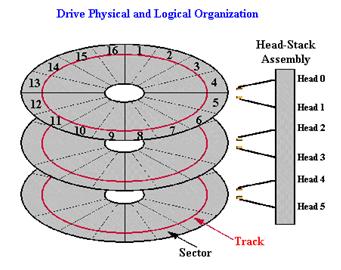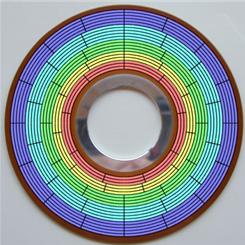Platters in physical
The physical material of Platters: Aluminum alloy comprises the physical material of the platter. It is rigid, easy to work with, lightweight, stable, inexpensive and readily available. The speed that the platters spin is increasing to store data much quicker and in intensive tracks, it is creating more demands on the platter material itself. That’s why the first glass Platters of IBM HDD failed to dominate the market;
Media Layer: The physical material (Aluminum alloy) of which the platters are made forms the base upon which the actual recording media is deposited. The media layer is a very thin coating of magnetic material which is where the actual data is stored, typically only a few microinches in thickness. The media layer is usually comprised of a special alloy. That’s why the data will lose or inaccessible by ages of using. It is because the thin media layer become dull or damaged and can’t react the signals from the HDD or commands from a PC;
Does it make any sense to wash Platters with distilled water or alcohol?
You must laugh at my silly question. But it happened, someone told me before that He did wash the platters with pipe water because there are many fingerprints on them, and, huh, according to his words, he had fixed it and that drive got working.
Can we put the hard drive near with some magnetic materials?
People put the hard drive in some antistatic storage and they avoid to put their credit cards and other magnetic cards together.
Protective Layer: The surface of each platter is normally covered with an extra-thin, protective, lubricating layer, on top of the magnetic media layer itself. This material is used to protect the disk from damage caused by accidental contact from the heads or other foreign matter that might get into the drive. That’s why you can use your HDD to store data for years, not for a couple of months;
Platters in Logically
Platters Divisions: The platter is divided into Tracks and Sectors and is read by Zone Recording or Clusters.
Tracks:
Platters are organized into specific structures to enable the organized storage and retrieval of data. Each platter is broken into several thousand tracks, which are tightly-packed concentric circles. (These are similar in structure to the annual rings of a tree.,see the circle in red of the Picture).
But, you will find that the ones on the outside of the platter are much larger than the ones on the inside–typically double the circumference or more. Since there is a constraint on how tight the inner circles can be packed with bits, they were packed as tight as was practically possible given the state of technology, and then the outer circles were set to use the same number of sectors by reducing their bit density. This means that the outer tracks were greatly underutilized, because in theory they could hold many more sectors given the same linear bit density limitations.
To eliminate this wasted space, modern hard disks employ a technique called zoned bit recording (ZBR), also sometimes called multiple zone recording or even just zone recording. With this technique, tracks are grouped into zones based on their distance from the center of the disk, and each zone is assigned a number of sectors per track. As you move from the innermost part of the disk to the outer edge, you move through different zones, each containing more sectors per track than the one before. This allows for more efficient use of the larger tracks on the outside of the disk.



